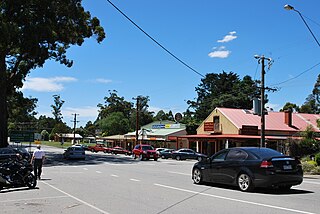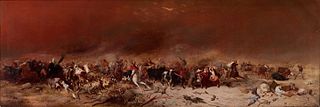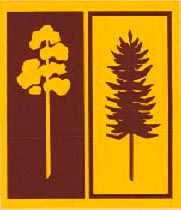
The Kinglake National Park is a national park in Central Victoria, Australia. The 23,210-hectare (57,400-acre) national park is situated 50 kilometres (31 mi) northeast of Melbourne and includes tracks, and camping facilities.

The Black Friday bushfires of 13 January 1939, in Victoria, Australia, were part of the devastating 1938–1939 bushfire season in Australia, which saw bushfires burning for the whole summer, and ash falling as far away as New Zealand. It was calculated that three-quarters of the State of Victoria was directly or indirectly affected by the disaster, while other Australian states and the Australian Capital Territory were also badly hit by fires and extreme heat. This was the third-deadliest bushfire event in Australian history, only behind the 1983 Ash Wednesday bushfires and the 2009 Black Saturday bushfires.

The Ash Wednesday bushfires, known in South Australia as Ash Wednesday II, were a series of bushfires that occurred in south-eastern Australia in 1983 on 16 February, the Christian holy day Ash Wednesday. Within twelve hours, more than 180 fires fanned by hot winds of up to 110 km/h (68 mph) caused widespread destruction across the states of Victoria and South Australia. Years of severe drought and extreme weather combined to create one of Australia's worst fire days in a century. The fires were the deadliest in Australian history until the Black Saturday bushfires in 2009.

Kinglake is a town in Victoria, Australia, 56 km (35 mi) north-east of Melbourne's Central Business District, located within the Shires of Murrindindi and Nillumbik local government areas.

Marysville is a town in the Shire of Murrindindi in Victoria, Australia, about 34 kilometres north-east of Healesville and 41 kilometres south of Alexandra. The town, which previously had a population of over 500 people, was devastated by the Murrindindi Mill bushfire on 7 February 2009. On 19 February 2009 the official death toll was 45. Around 90% of the town's buildings were destroyed. Prior to the Black Saturday fire the population in 2006 was 519. At the 2011 Census, the population had reduced to 226, by the 2016 census it had risen to 394.

The 2006–07 bushfire season was one of the most extensive bushfire seasons in Australia's history. Victoria experienced the longest continuously burning bushfire complex in Australia's history, with fires in the Victorian Alps and Gippsland burning over 1 million hectares of land over the course of 69 days. See Bushfires in Australia for an explanation of regional seasons.

The Australian bushfire season ran from late December 2008 to April/May 2009. Above average rainfalls in December, particularly in Victoria, delayed the start of the season, but by January 2009, conditions throughout South eastern Australia worsened with the onset of one of the region's worst heat waves. On 7 February, extreme bushfire conditions precipitated major bushfires throughout Victoria, involving several large fire complexes, which continued to burn across the state for around one month. 173 people lost their lives in these fires and 414 were injured. 3,500+ buildings were destroyed, including 2,029 houses, and 7,562 people displaced.

A particularly extensive bushfire season in Australia, ran predominantly from December 2002 to March 2003 and involved over 3,000 separate fires in Victoria alone. The 2003 Canberra bushfires were also particularly severe.

Bushfires in Australia are a widespread and regular occurrence that have contributed significantly to shaping the nature of the continent over millions of years. Eastern Australia is one of the most fire-prone regions of the world, and its predominant eucalyptus forests have evolved to thrive on the phenomenon of bushfire. However, the fires can cause significant property damage and loss of both human and animal life. Bushfires have killed approximately 800 people in Australia since 1851, and billions of animals.

The Black Saturday bushfires were a series of bushfires that either ignited or were already burning across the Australian state of Victoria on and around Saturday, 7 February 2009, and were one of Australia's all-time worst bushfire disasters. The fires occurred during extreme bushfire weather conditions and resulted in Australia's highest-ever loss of human life from a bushfire, with 173 fatalities. Many people were left homeless and family-less as a result.

The Black Thursday bushfires were a devastating series of fires that swept the Port Phillip District in Australia, on 6 February 1851, burning up 5 million hectares, or about a quarter of the state's area. Twelve people died, along with one million sheep, thousands of cattle and countless native animals.

A bushfire season occurred predominantly from June 2009 to May 2010. Increased attention has been given to this season as authorities and government attempt to preempt any future loss of life after the Black Saturday bushfires during the previous season, 2008–09. Long range weather observations predict very hot, dry and windy weather conditions during the summer months, leading to a high risk of bushfire occurrence.

The summer of 2012–13 had above average fire potential for most of the southern half of the continent from the east coast to the west. This is despite having extensive fire in parts of the country over the last 12 months. The reason for this prediction is the abundant grass growth spurred by two La Niña events over the last two years.
The Eastern Victoria Great Divide bushfires, also known as the Great Divide Complex, were a series of bushfires that commenced in the Victorian Alps in Australia on 1 December 2006 due to lightning strikes, and continued for 69 days. They were the longest running bushfires in the state's history. Between 1.2 and 1.3 million hectares were burnt, most of it public land. Victorian fire personnel were assisted by others from all states and territories of Australia, as well as teams from New Zealand, the United States and Canada.

The most destructive bushfire season in terms of property loss since the 2008–09 Australian bushfire season, occurred in the summer of 2015–16, with the loss of 408 houses and at least 500 non-residential buildings as a result of wild fires between 1 June 2015 and 31 May 2016. The season also suffered the most human fatalities since the 2008–09 Australian bushfire season; 6 died in Western Australia, 2 in South Australia and 1 in New South Wales. 8 deaths were as a direct result of fire, and a volunteer firefighter died due to unrelated health complications while on duty.

The Forests Commission Victoria (FCV) was the main government authority responsible for management and protection of State forests in Victoria, Australia between 1918 and 1983.

The 2019–20 Australian bushfire season, or Black Summer, was one of the most intense and catastrophic fire seasons on record in Australia. It included a period of bushfires in many parts of Australia, which, due to its unusual intensity, size, duration, and uncontrollable dimension, was considered a megafire by media at the time. Exceptionally dry conditions, a lack of soil moisture, and early fires in Central Queensland led to an early start to the bushfire season, beginning in June 2019. Hundreds of fires burnt, mainly in the southeast of the country, until May 2020. The most severe fires peaked from December 2019 to January 2020.



















